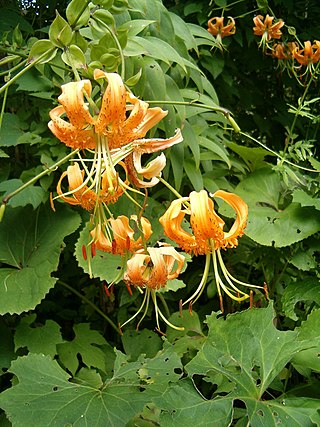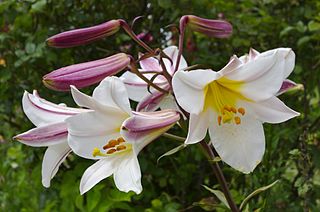Easter lily may refer to:
- Easter Lily (badge), an Irish republican badge
Easter lily may refer to:

In botany, a bulb is structurally a short stem with fleshy leaves or leaf bases that function as food storage organs during dormancy.

Lilium is a genus of herbaceous flowering plants growing from bulbs, all with large prominent flowers. They are the true lilies. Lilies are a group of flowering plants which are important in culture and literature in much of the world. Most species are native to the northern hemisphere and their range is temperate climates and extends into the subtropics. Many other plants have "lily" in their common names, but do not belong to the same genus and are therefore not true lilies.

The lily family, Liliaceae, consists of about 15 genera and 610 species of flowering plants within the order Liliales. They are monocotyledonous, perennial, herbaceous, often bulbous geophytes. Plants in this family have evolved with a fair amount of morphological diversity despite genetic similarity. Common characteristics include large flowers with parts arranged in threes: with six colored or patterned petaloid tepals arranged in two whorls, six stamens and a superior ovary. The leaves are linear in shape, with their veins usually arranged parallel to the edges, single and arranged alternating on the stem, or in a rosette at the base. Most species are grown from bulbs, although some have rhizomes. First described in 1789, the lily family became a paraphyletic "catch-all" (wastebasket) group of lilioid monocots that did not fit into other families and included a great number of genera now included in other families and in some cases in other orders. Consequently, many sources and descriptions labelled "Liliaceae" deal with the broader sense of the family.

Lilium mackliniae, the Shirui lily or Shirui Kashung Timrawon, is a rare Indian species of plant found only in the upper reaches of the Shirui hill ranges in the Ukhrul district of Manipur, India, at an elevation of 1,730–2,590 metres (5,680–8,500 ft) above sea level. It is located near the boundary of Myanmar to the east, Shirui village in the west, Choithar village in the south and Sihai village in the north.

Lilium bulbiferum, common names orange lily, fire lily,Jimmy's Bane,tiger lily and St. John's Lily, is a herbaceous European lily with underground bulbs, belonging to the Liliaceae.
Bermuda, Islands of Bermuda, or The Somers Isles is an Atlantic archipelago, British Overseas Territory, and a former part of Virginia.

Lilium longiflorum, often called the Easter lily, is a plant endemic to both Taiwan and Ryukyu Islands (Japan). Lilium formosanum, a closely related species from Taiwan, has been treated as a variety of Easter lily in the past. It is a stem rooting lily, growing up to 1 m high. It bears a number of trumpet shaped, white, fragrant, and outward facing flowers.

Lilium auratum is one of the true lilies. It is native to Japan and is sometimes called the golden-rayed lily or the goldband lily.

Lilium henryi, sometimes called tiger lily or Henry's lily, is a native lily of the mountains of central China. The flowers are orange, spotted black, and unscented. The petals are recurving, and eventually resemble those of the more widespread Turk's-cap lily.

Lilium speciosum is an East Asian species of plants in the lily family. It is native to southern Japan and southern China, where it can be found at elevations of 600–900 metres (2,000–3,000 ft). It is sometimes called the Japanese lily though there are other species with this common name.

Lilium pardalinum, also known as the leopard lily or panther lily, is a flowering bulbous perennial plant in the lily family, native to Oregon, California, and Baja California. It usually grows in damp areas. Its range includes California chaparral and woodlands habitats and the Sierra Nevada.

Lilium regale, called the regal lily, royal lily, king's lily, or, in New Zealand, the Christmas lily, is a species of flowering plant in the lily family Liliaceae, with trumpet-shaped flowers. It is native to the western part of Sichuan Province in southwestern China, and cultivated elsewhere as an ornamental. It was introduced to England in 1903 by Ernest Henry Wilson.
Tiger lily or Tiger Lily may refer to:

Lilium 'Stargazer' is a hybrid lily of the 'Oriental group'. Oriental lilies are known for their fragrant perfume, blooming mid-to-late summer. Stargazers are easy to grow and do best in full sunlight. They have a fast growth rate and should be planted in full sun in well-drained loamy or sandy soil. When mature, 'Stargazers' can grow to a height of 36 inches with a spread of 10 to 14 inches with 2 to 8 flowers per stem.
Lilies are members of Lilium, a genus of herbaceous flowering plants.
Lily, Lilium, is a genus of flowering plants with large flowers.
Leopard lily is a common name for several plants and may refer to:
Lilium is the plant genus of "true lilies".

The Lilieae are a monophyletic tribe of monocotyledon perennial, herbaceous mainly bulbous flowering plants in the lily family (Liliaceae).